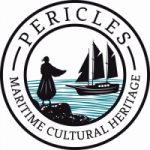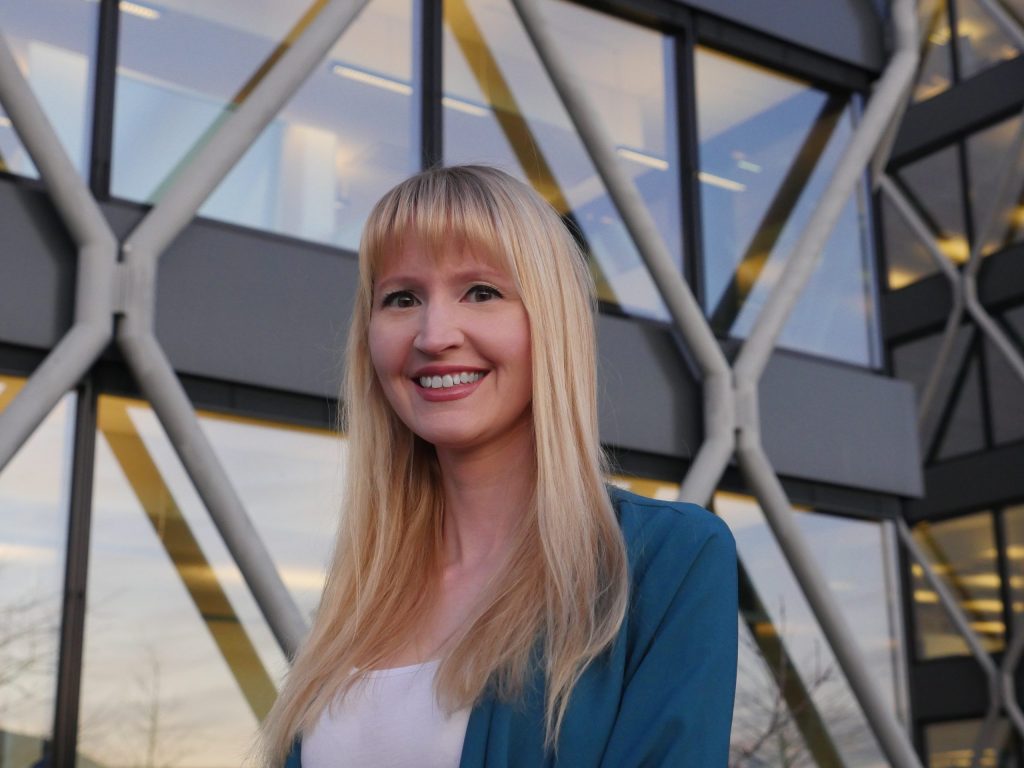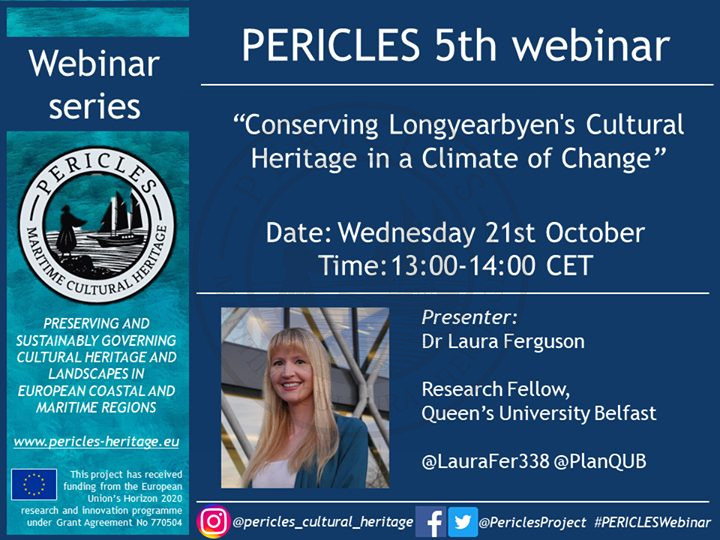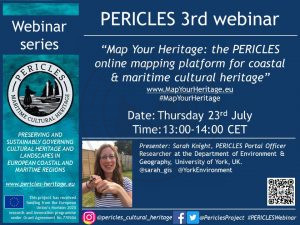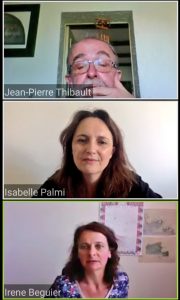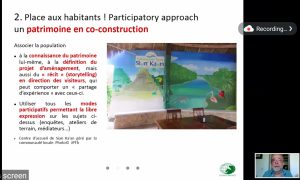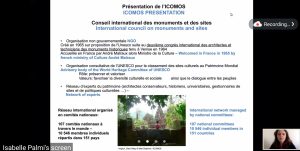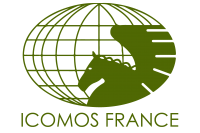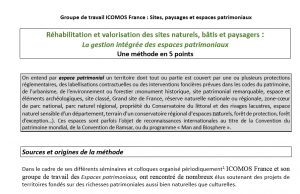
PERICLES WEBINAR SERIES
5th PERICLES Webinar: Conserving Longyearbyen’s Cultural Heritage in a Climate of Change
The fifth PERICLES webinar titled ‘Conserving Longyearbyen’s Cultural Heritage in a Climate of Change’ was presented by Dr Laura Ferguson of Queen’s University Belfast on 21st October 2020. Attendees came from 15 different countries, and included academics, heritage practitioners, and those involved in sustainable exploitation industries such as tourism. Laura discussed the tangible and intangible cultural heritage of Longyearbyen, the dynamics of the social and environmental changes impacting it and needs and options for the conservation of it. She presented the findings from a residents’ survey and interviews with people connected to heritage in Longyearbyen and demonstrated an Arctic Cultural Heritage Vulnerability Index in the town.
Laura kicked the webinar off by challenging the wilderness myth of the Arctic, telling us that in fact it has been inhabited, explored and exploited for hundreds of years. Longyearbyen, the largest settlement in the High Arctic Archipelago of Svalbard, was originally established as a company town for the Arctic Coal Company but has since evolved into a modern town with a thriving tourism industry and strong science and education base. The town has much cultural heritage, particularly relating to the mining industry.
Laura talked about cultural heritage in Longyearbyen; how it is conserved and how it is used for tourism, and the possible tensions between residents and the impact of tourism. She highlighted the issues of ‘uninherited heritage’. Longyearbyen has no indigenous population, but a very international group of residents with a high turnover. Residents have strong place-based connections with the town, and uninherited heritage is not seen as a barrier to cultural heritage ownership and conservation.
Laura talked about communities of meaning and participation and presented her findings from interviews with professionals involved in the conservation and development of Arctic industrial heritage (including debates surrounding artefacts as ‘heritage or junk’ and repurposed heritage). She also presented her findings from a survey of residents that explored contribution of mining heritage to place identity and heritage development for residents and/or tourists).
Laura then moved to discussing her work in constructing and testing an Arctic Cultural Heritage Vulnerability Index (ACHVI). The index aimed to be tailored to the Arctic setting, incorporating both environmental and site condition data, to assess the vulnerability of heritage assets in Arctic places, and was demonstrated in Longyearbyen. It involved an analysis of hazards (e.g. avalanches, sea level rise), exposure (pressure and consequences) and susceptibility to damage (state and condition of asset). The results were calculated and mapped, revealing the most vulnerable assets were original structures connected with its mining past. Laura highlighted the pros and cons of the index, and how it can be used to facilitate discussion and decision-making. She said that risk management of heritage not only involves mitigation and preservation strategies, but also the capacity building of all stakeholders (linking to the PERICLES Participatory Risk Assessment Framework).
Laura concluded by saying there is a definite commitment to heritage in Svalbard, and that it is an urgent matter given the pace of change in the region, both environmentally and socio-economically. The key challenges at present include disjoints caused by the uninhabited image and the heritage being uninherited, the difficulty in capturing and preserving intangible cultural heritage, and how to include the perspectives of residents to develop heritage that balances local benefits and tourism.
We then moved to a fascinating and engaging Q&A session with the audience, with Laura answering questions about policy take-up of evidence, gender dimensions, lessons learnt, some more methodological questions, and of course, how Covid-19 is affecting tourism in the area.
If you want to continue the discussion on these or any other topics relating to coastal and maritime cultural heritage, join @PericlesProject on Facebook or Twitter to keep the discussions on the #PERICLESwebinar going. We would love to hear from you!
Details of further PERICLES webinars and/or events will follow on social media and on our website, so keep a look out for those.
Read the summary of the webinar in French here
Did you miss the webinar??? Watch it right here:
4th PERICLES Webinar: Ethnographic documentary: a tool for the enhancement of intangible cultural heritage
The fourth webinar of the PERICLES Webinar Series, “Ethnographic documentary as a tool for the enhancement of cultural heritage” was an interactive delve into the use of a video technique to enhance intangible cultural heritage and encourage its protection. Presenters Dr Loes Witteveen and Pauline van Tuyll of Wageningen University discussed both the making of their documentary ‘The Whalers House’ (link), and questions regarding the use of ethnographic documentary more broadly.
Aided by the use of a clapboard and video clips Loes took the audience through the use of video ethnography as a tool, relating this to various theories at use in the PERICLES project, for example participatory and deliberative governance. This was followed by a review of the processes of making an ethnographic documentary, from start to finish (or idea development to distribution!). This was illustrated by Loes and Pauline’s own experiences making ‘The Whalers House’. Things are not always perfect- windy and rainy days can be troublesome for filming, and are relatively common phenomena on Texel…. We also learned about particular artistic and academic decisions, for example the use of the blue and white tiles , and the decision to highlight the role of women. After learning about the final production of the documentary, the next part of the webinar discussed its screening. The topics of ownership and the complicating role of COVID-19 was raised, and the decision to use YouTube and ‘International Museums Day’ to premiere the documentary presented. We hope that the documentary will have screenings at various physical festivals next year, but of course, this is somewhat up in the air. Finally, several questions for the future of ethnographic documentary as a tool were raised. These included the nature of the audiences for the films, but also the potential tension between ‘ethnography’ and ‘documentary’, which is yet to be clearly defined.
Short Q&A sessions were carried out at various intervals during the webinar, and it was great to hear questions about the content and production of ‘The Whalers House’, as well as requests for advice about using various video techniques in attendees’ own work in the future. If you want to continue the discussion on these or any other topics relating to coastal and maritime cultural heritage, join @PericlesProject on Facebook or Twitter to keep the discussions on the #PERICLESwebinar going. We would love to hear from you!
Details of further PERICLES webinars and/or events will follow on social media, so keep a look out for those.
Presenters:
Dr Loes Witteveen & Pauline van Tuyll, Uni. of Wageningen
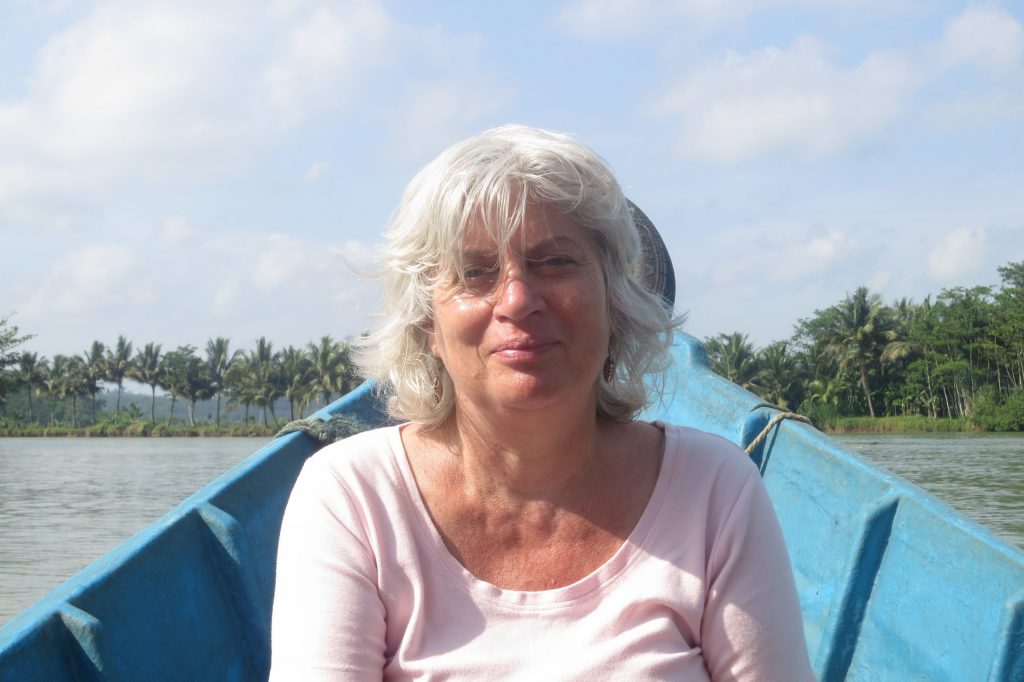
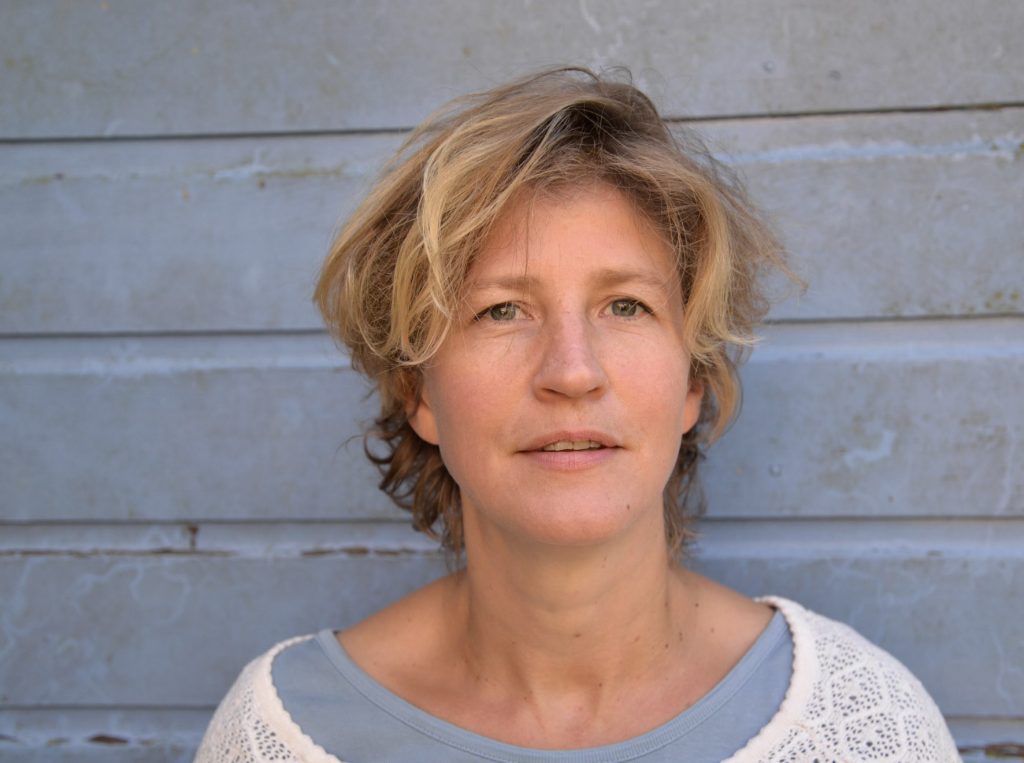
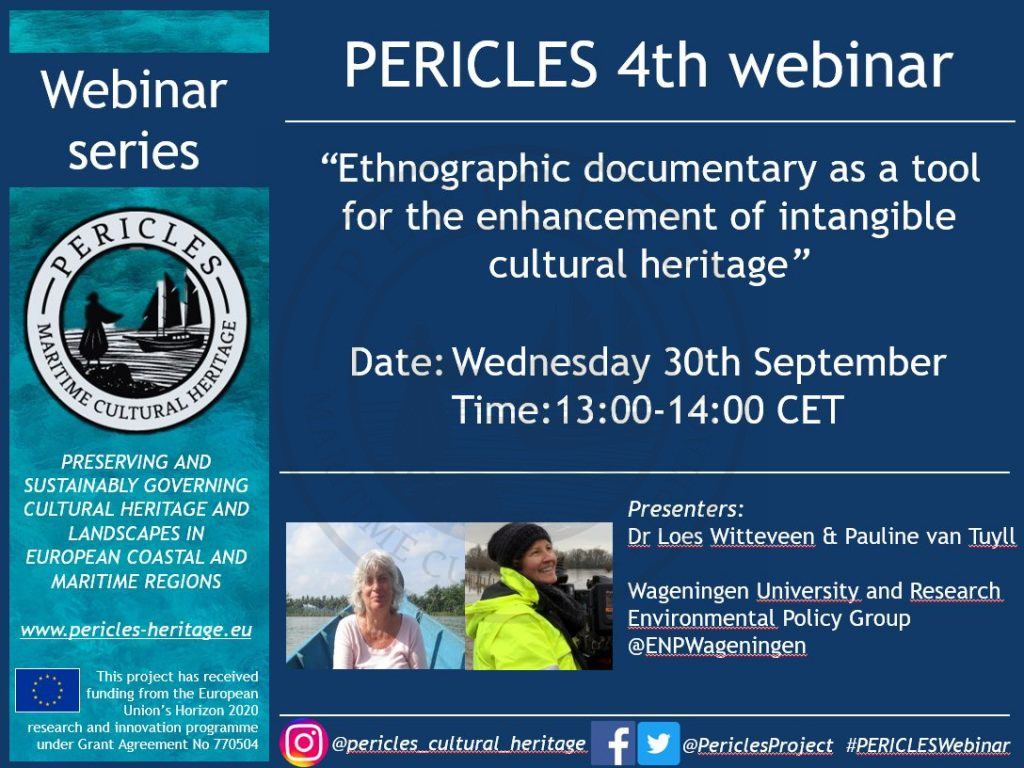
3rd PERICLES webinar ‘Map Your Heritage: the PERICLES online mapping platform for coastal and maritime cultural heritage’
Did you miss the webinar?? Luckily, the recording of the webinar can be found right here:
The third PERICLES webinar ‘Map Your Heritage: the PERICLES online mapping platform for coastal and maritime cultural heritage’, presented by Sarah Knight of the University of York, took place on July 23rd 2020. Attendees came from a wide range of countries, both within and outside the PERICLES case regions, and included academics, heritage practitioners, and stakeholders. Sarah presented a brief background to the PERICLES project and portal (https://mapyourheritage.eu/), before giving a live demonstration of the portal and answering questions from the attendees.
The webinar kicked off with an introduction to the PERICLES project and its various project partners and case regions, as well as the portal team. The portal was introduced as an interactive multimedia online platform, which facilitates cultural heritage data collection and mapping, allowing cultural heritage to be collected and viewed in a spatially explicit way. The portal aims to underpin work across PERICLES case regions and research themes, providing a holistic tool for project members and stakeholders as well as a reaching wider public audience. A key element of the portal is its participatory nature, which allows any individual to upload cultural heritage content and engage with other portal users and their data. Sarah elaborated the potential uses of the portal, which include use in participatory mapping workshops, online citizen science, crowd sourcing and school sessions.
After highlighting the key features of the portal, which included the different language options, existing data layers (EMODnet data), user uploaded points and commenting tool, Sarah gave a live demonstration of the portal – check out the video here (where is the video in relation to the text) for the full experience. In the demo, it was explained how to view both ‘official’ and ‘user added’ data, both individually and simultaneously, as well as how to engage with data points added by other users through commenting on their uploads. Sarah further walked attendees through how to upload a data point, and explained that anything uploaded would be covered by a creative commons copyright license. Following this, the process for making trails was described. Through linking a series of original and or user uploaded points it is possible to make a trail on the map, for example an ‘Industrial Marine Heritage in Belfast’ trail- this is a feature that could be useful both for the general public but also museums and the wider tourist industry. Finally, the bookmark feature was explained, which allows users to return to a specific location in or screen of the portal and carry on uploading, editing or analyzing data where they left off.
After the demonstration, Sarah briefly described the utility of the portal to various PERICLES case regions. The portal is being used in a variety of ways, including documenting and sharing both tangible and intangible cultural heritage, the promotion of traditions (for use in tourism), the marketing of cultural heritage, and the identification of risks to cultural heritage.
Following the presentation and demonstration, participants were invited to join a fruitful Q&A session, which included technical questions about the uploading of various kinds of data, as well as inquiries in to the future of the portal and the potential for collaborations. If you have any questions regarding the portal, please join @PericlesProject on Facebook or Twitter and ask away. Alternatively, you can use the ‘contact us & help’ link on the portal itself.
Finally, we would love you to get involved and contribute your own cultural heritage data to the portal! We look forward to seeing what you upload.
Presenter:
Sarah Knight, PERICLES Portal Officer
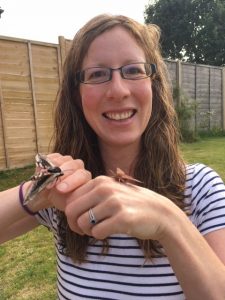
Sarah is an interdisciplinary researcher at the University of York, UK and a UK Data Service Impact Fellow, with an interest in GIS, mapping, ecosystem services and human well-being. She is currently researching the impact of the natural environment on human health and well-being, bringing together large environmental and socio-economic datasets across time and space. Prior to this she worked in the environmental conservation sector for nearly 10 years in government, charitable and academic organisations such as UNEP-WCMC, FERA, Imperial College and ZSL. She has an interest in employing quantitative, qualitative and participatory methods in research.
Sarah is the PERICLES Portal Officer, responsible for designing and delivering the technical aspects of the portal, as well as facilitating its use across the case regions. She is also responsible for the PERICLES social media channels and other dissemination activities. @sarah_gis
ICOMOS France: a definition and five principles for the enhancement of heritage areas
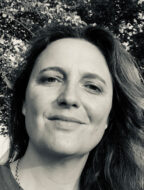
Isabelle Palmi, Director of ICOMOS France.
Jurist and art historian, Isabelle Palmi has been head of the French committee of ICOMOS since 2011. This NGO is UNESCO’s advisory organization for the classification of cultural sites as World Heritage. Isabelle is specifically in charge of the national and international promotion of the scientific work of ICOMOS France. Additionally, since 2016 she has been working for the French representation within the Nature Culture Process, organised each year as part of the joint ICOMOS-IUCN Connecting Practice programme.
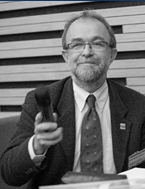
Jean-Pierre Thibault, Inspector General of Sustainable Development Administration and Administrator of ICOMOS France.
After his studies at the ENA, and a position at Historical Monuments Service of Paris City, Jean-Pierre THIBAULT discovered landscape during his time at the subdirectorate in charge of classified sites at the Ministry of Equipment (1988-91). Since then, in his successive assignments, particularly in decentralised services (DDE, DIREN, then DREAL), landscape has been the guiding thread of his actions in the public service, as well as in the associative framework (International Council on Monuments and Sites ICOMOS). Inspector General since 2014, he is also a member of the ‘Collective of post-oil period Landscapes’ recently created to promote the link between the landscape approach and energy transition (http://www.paysages-apres-petrole.org/).
2nd PERICLES webinar recording available:
The 2nd PERICLES webinar, organised in partnership with ICOMOS France, took place on June the 24th, 2020 with a global audience of 105 participants. This webinar was presented by Isabelle Palmi, Director of ICOMOS France and Jean-Pierre Thibault, Inspector General of Sustainable Development Administration and Administrator ICOMOS France.
First, Isabelle Palmi presented the NGO ‘International Council on Monuments and Sites’ (ICOMOS). ICOMOS is the UNESCO advisory body for the classification of cultural sites as World Heritage, and brings together an international network of heritage experts, organised in national committees. ICOMOS is at the heart of the process of the inclusion of cultural properties on the World Heritage List, and is a leading institution for heritage management. It produces doctrinal reference texts (Charter, declarations, etc.) and international scientific committees. The ICOMOS France section, created in 1965 has been characterized by integrated local authorities and local elected officials from the outset. The scientific action of ICOMOS France is reflected in national think-tanks, such as the “Sites, Landscapes and Heritage Areas” group, which join international approaches, such as Parcours Nature Culture
Following this introduction, Jean-Pierre Thibault outlined the five methodological principles for the economic and social valorisation of a heritage area advocated by ICOMOS France. He emphasised an integrated approach to “heritage”, bringing together nature and culture in an inseparable way. A five-point method was established after a dozen years of hearings of actors and case studies. These five points are as follows:
1. It is essential, at an early stage of the project, to collectively research the natural and cultural values of the territory. This makes it possible to arrive at a declaration of the natural and cultural values of the site.
2. A major place must be given to the inhabitants and local actors. They will contribute to the knowledge of the heritage, but also to the definition of the development project on which this heritage is based, and to the narrative presented to visitors.
3. The project, thus founded, must be both imbued with a long-term vision and materialized by tangible achievements that are sufficiently rapid to maintain interest in the project. The accumulation of small works without an overall vision risks leading to inconsistencies.
4. A project and its implementation must be regularly evaluated to assess the state of the heritage itself, but also the satisfaction of visitors (and the well-being of local inhabitants and socio-economic actors).
5. Finally, the constantly evolving nature of heritage, whether natural, landscape or cultural, must be assumed. It is therefore necessary to regularly adjust or redefine the enhancement project.
Following on from the presentation, the participants were invited to join a productive Q&A session where many topics were addressed. Topics included the identification of heritage areas to be enhanced, the place of intangible heritage, the inclusion of tourism in these enhancement processes, the participatory approaches to be used and developed, and many others which can be (re)discovered through the webinar video. If you want to get involved in these or any other topics relating to coastal and maritime cultural heritage, join @PericlesProject on Facebook or Twitter to keep the discussions on the #PERICLESwebinar going. We would love to hear from you!
Links shared during the webinar:
PERICLES: understanding coastal & maritime cultural heritage, its meanings, risks, and potentials
1st PERICLES webinar recording available:
The first PERICLES webinar took place on 27th May 2020 with a global audience of 140 participants. Project Coordinator Kristen Ounanian from the Centre for Blue Governance, University of Aalborg, introduced the PERICLES project and the PERICLES interactive mapping portal, illustrating some of the project’s key themes through examples from our case study demonstrations (demos).
Kristen presented the theoretical framing of the project, first outlining the PERICLES understanding of what constitutes coastal and maritime cultural heritage (CMCH), stressing the importance of recognizing both the tangible and intangible heritage. Crucial to the PERICLES understanding of CMCH is that it is dynamic and changeable, and this has led to the development of a spectrum of cultural heritage approaches between preservation to provide continuity and a transformative approach that adapts and evolves. Within this dynamic setting, the PERICLES Framework is built from the Three Pillars: 1. Space, Place and Identity, 2. Risk Resilience and Adaptation, and 3. Participatory and Deliberative Governance, which Kristen introduced. She illustrated Space, Place and Identity within a continuity context through the example of maritime cultural heritage markers that are maintaining marginalized shipyard heritage in the Belfast Port demo in Northern Ireland, and are an integral part of the survival of shipyard identity within these communities.
The focus then moved to the project’s ongoing work on risk. CMCH faces many threats, both environmental and man-made that require risk assessing for potential mitigating action. A significant development in the process of producing the comprehensive PERICLES framework is the participatory risk assessment framework, which will be a key tool for more effective analysis and response to risks. Kristen introduced webinar participants to the methodological steps of the PERICLES participatory risk assessment framework which is currently being assessed in demos across all case regions. The framework integrates participation at every step of the risk assessment process. Designed in two phases, the first phase ensures that participation in anchored in the assessment methodology, while the second phase follows general risk assessment steps but is implemented using participatory methods.
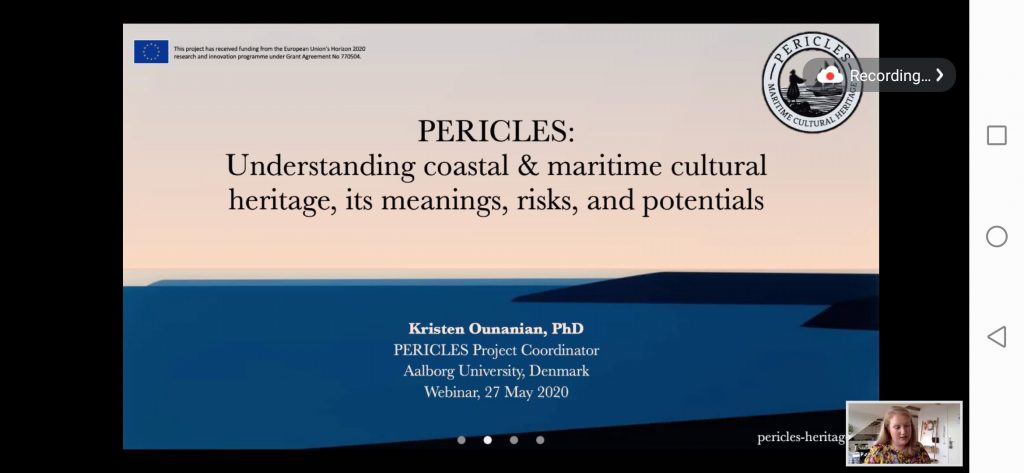
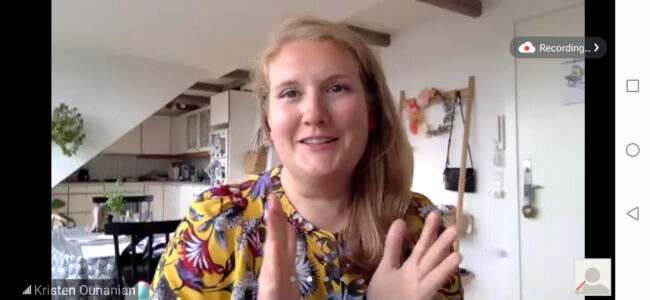
The webinar was delivered by our project coordinator, Dr Kristen Ounanian from the Centre for Blue Governance, Aalborg University.
Kristen then talked about cultivating a participatory approach to CMCH. The PERICLES understanding of participation focuses on the ideas of ‘communities of meaning’ and ‘communities of participation.’ A community of meaning consists of a diversity of actors with a common view of heritage and heritage connection, and a community of participation forms the governance setting. Communities of meaning and communities of participation define and develop practices of CMCH within their frame of reference. PERICLES recognises their participation is a prerequisite to sustainable management, conservation and use of coastal and maritime cultural heritage. Successful deliberative participatory governance among communities of meaning was illustrated through an example from PERICLES work in Locmariaquer, France, where participatory methods have been extensively deployed.
Following on from the presentation, participants were invited to join in for the Q&A session where we had an engaged discussion on many topics, including the threats of tourism, participatory methods used to engage with communities, and interest in extending the portal mapping across Europe. If you want to continue on these or any other topics relating to coastal and maritime cultural heritage, join @PericlesProject on Facebook or Twitter to keep the discussions on the #PERICLESwebinar going. We would love to hear from you!
Details of further PERICLES webinars this summer will follow on social media, so keep a look out for those.
